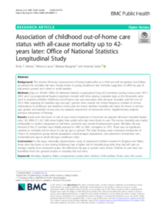Displaying 381 - 390 of 2214
This guidance from Miracle Foundation outlines case management process and tools aimed at children in Child Care Institutions (CCIs) in India who have been placed with their families during the COVID-19 pandemic. The purpose of these case management processes and tools is to determine feasibility of permanent placement and expedite family-based care in families in which children were placed quickly and without proper preparation during COVID-19 lockdown.
This study aims at comparing subjective well-being (SWB) of children in residential care and in foster families in two European territories or jurisdictions: Portugal and Catalonia (Spain).
The subject of investigation in this study is the principles of foster care, including the assumptions and solutions.
This exploratory secondary data analysis compares demographics, mental health/well-being, and protective mothering strategies of mothers who have experienced intimate partner violence (IPV) whose children were taken into care compared to those whose children were not to identify key characteristics associated with children being removed by child protective service (CPS) in Western Canada.
This study examined whether childhood out-of-home care was associated with all-cause mortality until the end of 2013 in the UK.
The aim of this study was to investigate the prevalence of depression, anxiety, and resilience in Eritrean unaccompanied refugee minors living with foster parents in Sudan.
The purpose of this study was to evaluate the consequences of criminal justice–related prenatal substance use policies for family reunification and to examine differences in parental reunification by racial/ethnic group.
The current study uses two randomized control trials, one conducted with foster caregivers and one conducted with birth parents, to investigate the longitudinal effects of caregiver type (foster versus birth parent) and a home-visiting parenting intervention on emotion regulation among young children referred to Child Protective Services (CPS).
This paper examines the frequency with which transition-age foster youth receive asset building services and whether the youth who receive services experience improved outcomes compared to those who do not.
This article presents a multi-site evaluation of a group delivery of the eight-week Circle of Security-Parent DVD program (COS-P) program to foster carers of 6-12 year-old children in an urban community as facilitated by community-based providers from a specialist child and youth mental health services.


